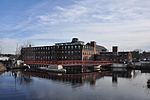Double-arch Sandstone Bridge
Bridges completed in 1735Bridges in Essex County, MassachusettsBuildings and structures in Methuen, MassachusettsMethuen, MassachusettsNational Register of Historic Places in Methuen, Massachusetts ... and 2 more
Road bridges on the National Register of Historic Places in MassachusettsStone arch bridges in the United States

The Double-arch Sandstone Bridge or more commonly known as the Sands Bridge, is a historic dry stone arch bridge over the Spicket River on Hampshire Road in Methuen, Massachusetts. Built without mortar between the stones, parts of it date back to 1735. It was used to handle traffic between Methuen and Salem, New Hampshire.
Excerpt from the Wikipedia article Double-arch Sandstone Bridge (License: CC BY-SA 3.0, Authors, Images).Double-arch Sandstone Bridge
Hampshire Road, Methuen
Geographical coordinates (GPS) Address Nearby Places Show on map
Geographical coordinates (GPS)
| Latitude | Longitude |
|---|---|
| N 42.7425 ° | E -71.208055555556 ° |
Address
Hampshire Road
Hampshire Road
01844 Methuen
Massachusetts, United States
Open on Google Maps









